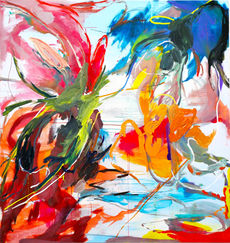XIYAO WANG
b. 1992, Chongqing, China
Currently lives and works in Berlin, Germany
Xiyao Wang’s abstract painting can best be described as movement captured on canvas, as expressing a feeling of boundlessness and unbridled life energy. She combines various techniques such as oil and acrylic paint, chalk, graphite, and oil sticks, because she sees different materials as being like different people, each with its own personality and its own character. Her works have the ability to sweep the viewer along, allowing a journey into the depths of the picture. Contrasting starkly with European abstract art, Wang’s lines are loaded with positive energy. In the Chinese artistic tradition, she admits the beauty and joie de vivre which Western art has long since consciously encased in bitterness. Her paintings are a delicate, semi-conscious dance that inspires a feeling of happiness in the viewer, like being touched by nature, akin to how one might feel in springtime.
Xiyao Wang graduated with a BA from Sichuan Fine Art Institute in 2014 and later completed her second degree at the University of Fine Arts of Hamburg in 2018. She obtained two MFAs, one from the State University of New York at Purchase in 2019 and one from the University of Fine Arts of Hamburg in 2020. Selected solo exhibitions include “Wingless Shadow,” Tang Contemporary Art, Seoul (Korea, 2025); “Lightly Floats and drifts the boat” Konig Galerie (Mexico City, Mexico 2024); “Before the Sun Goes Down,” Tang Contemporary Art, Bangkok (Thailand, 2024); “The Blue Hour,” Massimo De Carlo Gallery (Milan, 2024); “Touching the Invisible,” Song Art Museum, Beijing (China, 2024); “Do you hear the waterfall?” Perrotin, New York (US, 2024); “On the Way to Penglai Island,” König Galerie, Berlin (Germany, 2023); “The Endless Dream,” Arndt Collection, Melbourne, Cape Schanck (Australia, 2022); “Castel in the air,” Geber Stauffer Fine Arts, Zurich (Switzerland, 2021), etc.
She has also participated in numerous institution exhibitions in recent years, including the Bangkok Biennale, Bangkok (Thailand, 2024), De Sculptura, Albertina Museum, Vienna (Austria 2025); “Image Scripts,” Galaxy Museum of Contemporary Art, Chongqing (China, 2025); Art Basel, Paris (France, 2024); “Boundless Reverie: Chinese Savoir-Faire and Contemporary Art,” K11 Art Foundation (Hong Kong, 2024); “The Arndt Collection: From One World to Another,” Shepparton Art Museum, Victoria (Australia, 2024); “Questionings on Painting,” CAFA Art Museum, Beijing (China, 2024); “Translations: Afro-Asian Poetics,” The Institutum, Singapore (Singapore, 2024); “Symphony of Coexistence – Chinese and Southeast Asian Art Invitational Exhibition,” The Art Museum of Sichuan Fine Arts Institute, Chongqing (China, 2024); “Unknown/Chronology/Object,” Pingshan Art Museum, Shenzhen (China, 2023); “The Arndt Collection: From One World to Another,” Shepparton Art Museum, Victoria (Australia, 2023); “The Collection Exhibition of Art Museum of Sichuan Fine Arts Institute,” Art Museum of Sichuan Fine Arts Institute, Chongqing (China, 2023), etc.
















